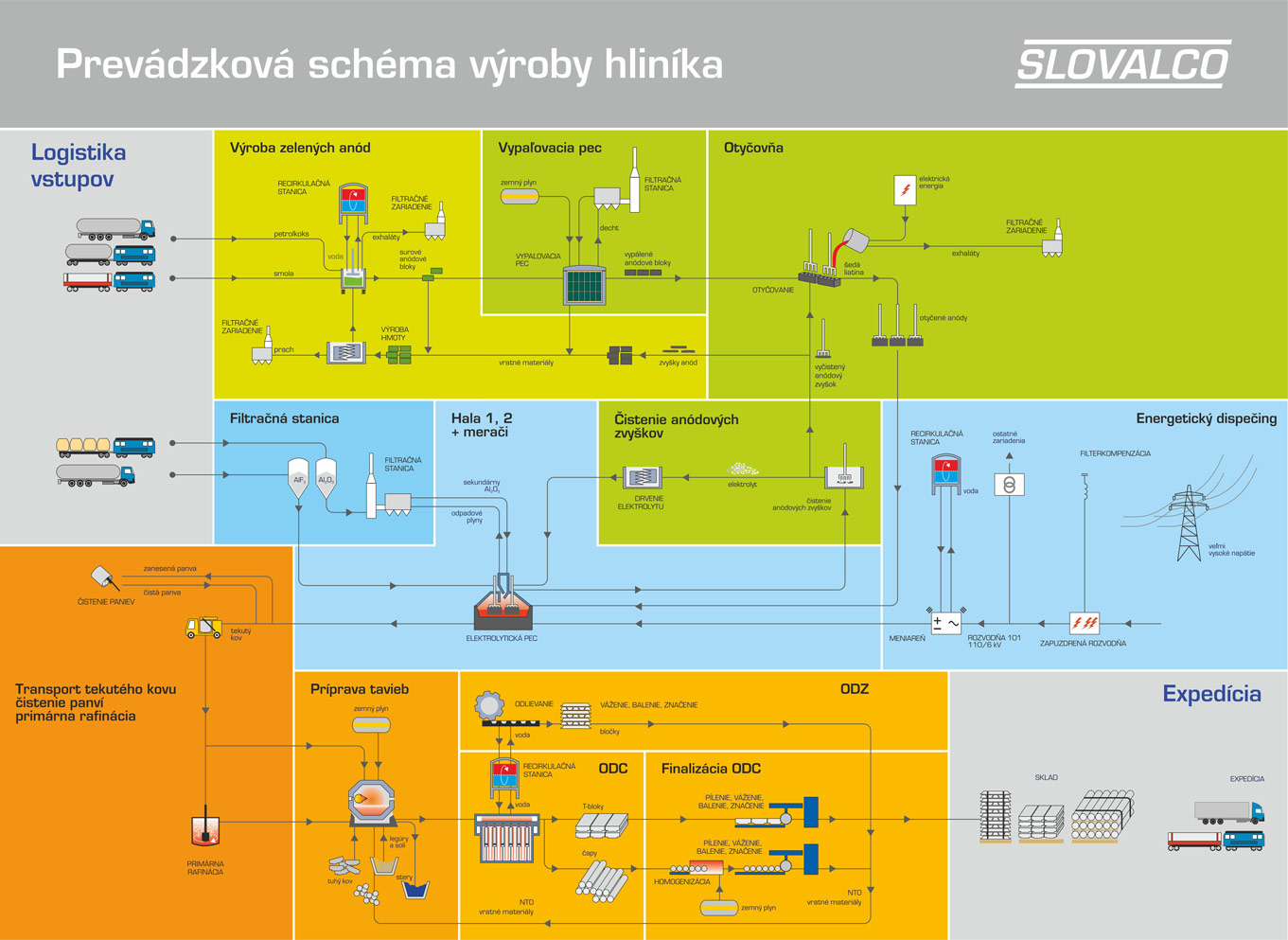Aluminium Production
Input raw materials
SThe heart of aluminium production in Slovalco is the Potroom where aluminium is produced from input raw materials by use of electric power.
A coarse grain alumina (Al2O3) is used for the production of aluminium; it is transported by train in special closed tanks. Alumina stored in silos is then transported in closed fluidized conveyers and tubes (dense phase system) through the fume treatment plants into the pots.
Another important raw material for production of aluminium is aluminium fluoride (AlF3) which is a bath ingredient in the electrolytic process of aluminium production.
Another important raw material for production of aluminium is aluminium fluoride (AlF3) which is a bath ingredient in the electrolytic process of aluminium production. Aluminium fluoride is fed into the pots as a bulk material.
Prebaked anodes are also an important input product. They are put into the pots and consumed during the electrochemical process/production of primary aluminium. Anodes are made in dedicated production facility from calcined petrolcoke and pitch. Green anodes are baked in baking furnace. They are shaped as blocks weighing up to 1, 5 tons. Anodes usually have four stub holes for connection to rods. The rods are holding anodes immersed in bath.
Electric power is an irreplaceable part of aluminium production. Electrolytic production of aluminium is a process with extra high demand for energy; that’s why Slovalco is the largest single consumer of electric power in the Slovak Republic.
Production of aluminium
The Potroom, where primary aluminium is produced, has an impressive length of 806, 4 meters and includes 226 pots. In each pot, purified alumina dissolves in molten cryolite and undergoes electrolysis enabled by direct current. Electric current makes oxygen to deposit on carbon anode and to be released as carbon dioxide, while free molten aluminium (which is heavier than electrolyte) deposits on carbon lining at the bottom of the pot. After the pure metal surface reaches certain level, the metal is tapped out with vacuum equipment from the pot into the crucibles.
Casting of aluminium products
Liquid aluminium is treated in melting and holding furnaces. Slovalco, a. s., has got three 35-tonnes furnaces and two 30-tonnes furnaces. The production process consists of cast preparation, casting and finishing.
The production process consists of cast preparation, casting and finishing.
The casting starts with feed materials dosing into the melting and holding furnaces. The cold metal purchased from external sources, discrepant aluminium products and internal technological scrap are heated by gas burners to the temperature, when it is possible to add liquid metal from the Potroom at the temperature of approximately 850 °C. Heated cold charge is heated and melts as it absorbs high temperature from liquid metal. At the same time the temperature of liquid metal is decreased to desired level and the cold charge forms in the pure electrolytic metal the required inner structure. Also alloying is a part of the cast preparation, i. e., certain alloying agents are added to the furnace according to the chemical composition specification in order to produce alloys featuring desired physical and chemical properties. A content of charged furnace is stirred in order to provide melting-down and even composition of the whole charge. Undissolved particles, impurities and products of burning process rise to the surface and are skimmed as a dross. Due to relatively high aluminium content also dross is sold to our customers, who extract from it aluminium, which is returned to the production process as the alloying agent. Primary metal tapped from the pot is 99, 8% pure aluminium.
Casting
The casting process starts with a refining of metal which flows through launders towards casting equipment. Slovalco, a. s., uses two 4-chambers and two 2-chambers refining reactors, which eliminate unwanted elements and particles from the liquid metal in the launder system very efficiently. Treated metal is cast into extrusion ingots and PFA ingots. The Company uses two casting centers for extrusion ingots casting. Cast products are cooled down with water. Most of ingots are homogenized. They are heated in special furnace up to app. 580 °C and through rapid cooling their inner microstructure is modified. Extrusion ingots are afterwards cut to desired lengths.
Eventually, all products are weighted, packed and transported to storage areas from where they are prepared for shipping.



